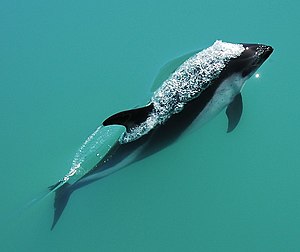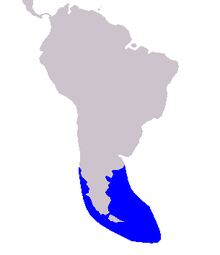Peale dolphin
| Peale dolphin | ||||||||||||
|---|---|---|---|---|---|---|---|---|---|---|---|---|

Peale dolphin ( Lagenorhynchus australis ) |
||||||||||||
| Systematics | ||||||||||||
|
||||||||||||
| Scientific name | ||||||||||||
| Lagenorhynchus australis | ||||||||||||
| ( Peale , 1848) |
The Peale dolphin ( Lagenorhynchus australis ), also known as the " Black-chinned Dolphin " in English , is a small dolphin that is native to the area around Tierra del Fuego , the southern tip of South America. It belongs to the short-snouted dolphins ( Lagenorhynchus ).
The Peale dolphin has a sturdy build with a short, strong jaw. The fin in the middle of the body is high and curved. There are 29–34 pin-like teeth in the upper and lower jaw. The body color is complex and individually different: The face (lips and chin) and the top of the back are dark, the fin (dorsal fin), which is also dark, is lighter on the back. This mostly gray spot blends into the dark color. A dark stripe extends across the back of the back diagonally to the center of the body, separating two light gray areas - a large one on the front and a smaller one on the flanks. The underside of the abdomen and the area around the flippers are white. A dark stripe from the corner of the mouth to the genital opening separates the gray sides from the white lower abdomen.
This species of dolphin can be found near the coast, mostly from 38 ° S in the southwest Atlantic, via Cape Horn to north in 33 ° S in the southeastern Pacific. Peale dolphins are the most common dolphins found along southern Patagonia, Tierra del Fuego, and they also inhabit the cliffs of the Falkland Islands. It can also be found in the tidal waters and kelp forests. The preferred water temperature is 15 ° C.
These toothed whales are usually in groups of 2 to 7 up to 20 and especially in summer and autumn in family groups of 100 animals. They are often seen patrolling shallow coastal waters. Despite their slow appearance, peale dolphins are active swimmers (jumping out of the water and playing near boats), riding waves, and zigzagging through the water. Often times, Peale dolphins team up with Commerson dolphins.
features
When fully grown, the Peale dolphin is 2.10 meters long and weighs around 115 kilograms. The face and chin of the animals are dark gray, the back largely black with a white line on both sides that curvily along the back. The belly is white. Behind the pectoral fins ( flippers ) they also have a white spot and on the flanks there is a gray-white field above the flippers. The dorsal fin is relatively large, the flippers are rather small and pointed. The fluke also ends in two pointed ends and has a constriction in the middle. When sighted from a greater distance, there is a particular risk of confusion with the black dolphin ( Lagenorhynchus obscurus ).
distribution
The peale dolphin is endemic to the coastal waters around southern South America. The northernmost sighting so far is on the Pacific side near Valdivia in Chile at the 38th parallel south latitude. On the Atlantic side, the animals are sighted up to about 44 degrees, at the level of the Golfo San Jorge in Argentina . To the south the area extends to the Drake Strait at about 60 ° south latitude.
They obviously prefer waters with strong tidal currents or currents in straits and canals. Nothing is known about the population size .
behavior
Peale dolphins gather in small groups with an average of five to 20 animals, and schools with up to 100 animals can rarely be seen, especially in summer and autumn. Most of the animals swim one behind the other along the coast. They usually swim relatively slowly, but they can accelerate suddenly.
Threat and protection
Since the Peale Dolphins often swim near the coast and only use a fairly small area, they are relatively easy to catch. Especially in the 1970s and 1980s, thousands of the animals were killed by Chilean fishermen and used as bait for crab fishing . This practice has decreased, but has never been banned. In Argentina, many dolphins get caught in fishing nets, but the exact number is not known. Above all, whale conservation organizations such as the Whale and Dolphin Conservation Society warn that this species must be better researched.
See also
- Lagenorhynchus australis inthe IUCN 2013 Red List of Threatened Species . Posted by: Hammond, PS, Bearzi, G., Bjørge, A., Forney, K., Karczmarski, L., Kasuya, T., Perrin, WF, Scott, MD, Wang, JY, Wells, RS & Wilson, B., 2008. Retrieved December 29, 2013.
literature
- Mark Carwardine: Wale und Delfine Delius Klasing, Bielefeld, 2008, ISBN 978-3768824736 .
- Mark Carwardine: Dolphins - Biology, Distribution, Observation in the Wild. Naturbuch, Augsburg 1996, ISBN 3-89440-226-1 (informative illustrated book).
- Ralf Kiefner: whales and dolphins worldwide. Year Top Special, Hamburg 2002, ISBN 3-86132-620-5 .
- J. Niethammer, F. Krapp (ed.): Handbook of mammals in Europe. Volume 6. Marine mammals, T 1a. Wale und Delphine 1. Aula, Wiesbaden 1994, ISBN 3-89104-559-X .
